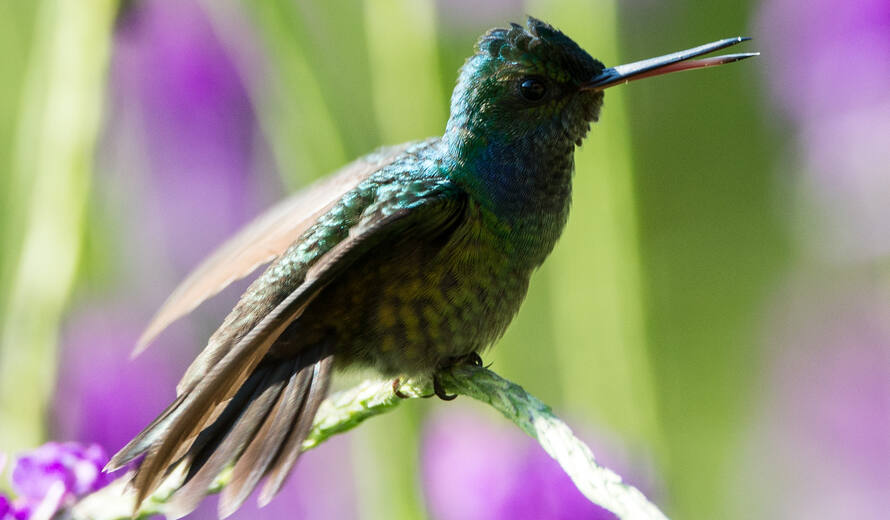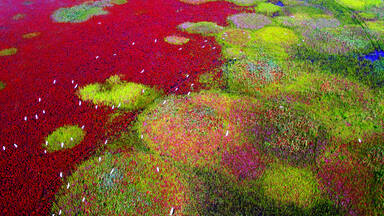World Migratory Bird Day 2023: Water Sustaining Bird Life
13 May 2023 – World Migratory Bird Day highlights the importance of water for migratory birds and calls for more action to protect water resources and aquatic ecosystems. UNESCO World Heritage sites are crucial safe havens for all 12 migratory bird species that are celebrated today.
Water is fundamental to life on our planet. Many migratory birds rely on aquatic ecosystems during their life cycles. Inland and coastal wetlands, rivers, lakes, streams, marshes, and ponds are all vital for feeding, drinking, or nesting, and also as places to rest and refuel during their long journeys.
Unfortunately, aquatic ecosystems are becoming increasingly threatened around the world and so are the migratory birds that depend on them. The increasing human demand for water, as well as pollution and climate change, are having a direct impact on the availability of clean water and the conservation status of many migratory birds. Climate change is amplifying the impact of habitat destruction by depleting natural water systems and depriving migratory birds of vital breeding and stopover site. These sobering examples go hand-in-hand with recent reports that reveal that the populations of 48 percent of bird species worldwide are in decline.
Today’s World Migratory Bird Day celebrates 12 bird species in particular of which 8 find safe havens in natural UNESCO World Heritage sites.
The Dalmatian Pelican reminds us that many species need wetlands and open water for migration, wintering, and breeding. The Srebarna Nature Reserve (Bulgaria) hosts the only colony of Dalmatian Pelican in Bulgaria, while the wetlands of Saryarka – Steppe and Lakes of Northern Kazakhstan (Kazakhstan) are key stopover points on the Central Asian flyway.
Some birds require specific types of water habitats, such as the tidal flats of the Migratory Bird Sanctuaries along the Coast of Yellow Sea-Bohai Gulf of China (Phase I) (China), that Spoon-billed Sandpipers (Calidris pygmaea) - one of the world’s rarest migratory birds - use during migration and winter.
Other birds depend on mangrove forests, such as the Black-capped Kingfisher, which is a common visitor of the Sundarbans (Bangladesh).
Water is essential for the growth of nectar-producing plants frequented by various types of Hummingbirds, such as the Chiribiquete Emerald Hummingbird, endemic to the Chiribiquete National Park – “The Maloca of the Jaguar” (Colombia); the Mangrove Hummingbird, protected in the Area de Conservación Guanacaste (Costa Rica); or the Giant Hummingbird in the Huascaran National Park (Peru).
The Atlantic Puffin and Wandering Albatross represent the oceans that make up 97 percent of all water on earth. Approximately 38 % of the global population of Wandering Albatross (Diomedea exulans) breeds in the French Austral Lands and Seas World Heritage site (France), an ‘oasis’ in the middle of the Southern Sea which supports one of the world’s highest concentrations and diversities of marine birds.
With nearly one million seabirds present at the height of the breeding season – including Atlantic Puffin - St Kilda supports the largest seabird colony in the north-east Atlantic, its size and diversity of global significance making it a seabird sanctuary without parallel in Europe. The very high bird densities that occur in this relatively small area, conditioned by the complex and different ecological niches existing in the site and the productivity of the surrounding sea, make St Kilda unique.
And finally, the Osprey serves as a conservation success story, reminding us that bird population declines can be reversed when we work together to conserve and protect our planet. A major resident osprey population can be found in the Whale Sanctuary of El Vizcaino (Mexico), whose birds
depend on the lagoons and adjacent habitats. Meanwhile the ospreys of the Belize Barrier Reef Reserve System (Belize) are a testament to the property’s importance and its ecological integrity. Ospreys are also a flagship species of the Gulf of Porto: Calanche of Piana, Gulf of Girolata, Scandola Reserve (France). Once a stronghold for the Corsican population, its breeding population is today under pressure because of disturbance linked to visitation pressure.
World Migratory Bird Day is a global campaign that aims to raise awareness of migratory birds and the need for international cooperation to conserve them. The two peak days of World Migratory Bird Day 2023 will be 13 May and 14 October, reflecting the cyclical nature of seasonal bird migrations. Events will take place all over the world in parks, World Heritage sites, nature centers, museums, libraries, schools, and other locations on those two peak days as well as throughout the year. To find an event near you, to register your own event, or to download this year’s campaign poster in multiple languages, go to: https://www.worldmigratorybirdday.org/


